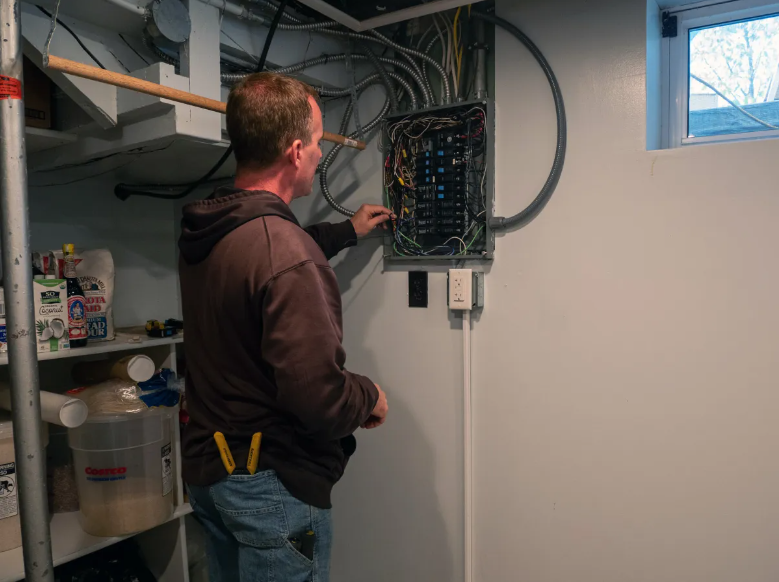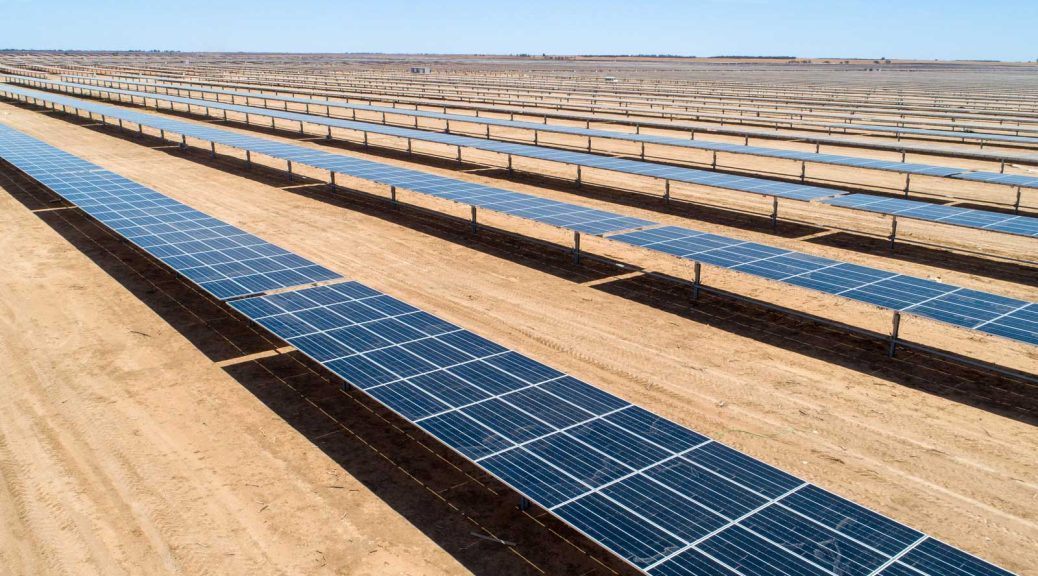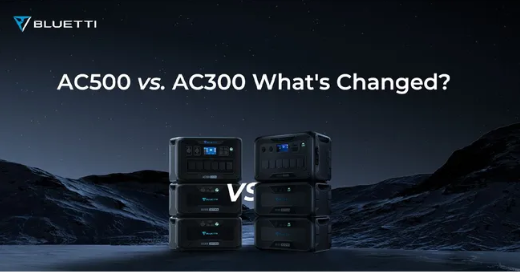Older homes were not designed for big electrical loads, but new technology could help fix that.

\An electrician prepares to upgrade a 100 amp electric panel in a Minneapolis home. Credit: Jo Olson / Creative Commons
Heat pumps, induction stoves and other electric devices are increasingly seen as key to a clean energy future. And most new homes have electric service robust enough to handle them.
But older homes were not designed for big electrical loads, and millions will require updates before those new appliances can be safely plugged in.
In states like Minnesota, where old homes with natural gas furnaces and water heaters are common, upgrading electric panels “is going to be huge,” said Eric Fowler, senior policy associate for buildings at Fresh Energy, a clean energy advocacy group that also publishes the Energy News Network. “As we move toward electrification, that bottleneck is going to be the electric panel.”
In Minneapolis alone, the Center for Energy and Environment estimates owners of one- to four-unit buildings could spend between $164 million and $213 million to improve electric service. Pecan Street, a national research organization, found at least 48 million homes nationally may need electric panel upgrades.
And while changing out the electrical panel itself is fairly straightforward, bringing an older home with 60 or 100 amp service to a modern standard of 200 amps may require more extensive utility upgrades that can rack up thousands of dollars in additional costs.
Fowler said electricians modernize the panel of circuit breakers and, if needed, conduct a “service upgrade” to improve the wiring to carry more current between the home and the electric grid. “That upgrade cost can vary wildly, especially if it requires digging underground, potentially under pavement that will need repair,” he said.
One potential solution is a “smart panel” that could help manage the load, eliminating the need for a bigger utility line. While all the electrical devices running simultaneously could overwhelm a 100 amp service, a smart panel would manage those loads to ensure that limit is never reached.
“A smart panel lets you do the first upgrade without the second — you can manage more circuits with the same amount of electricity with slight adjustments in the timing of your electricity use,” Fowler said.
Legislature considering incentives
The Minnesota Legislature is considering House and Senate bills offering income-eligible grants to owners of homes and apartments to upgrade their electric panels to a higher amperage or purchase smart panels. The federal Inflation Reduction Act also contains home electrification incentives that could be applied to smart panel investments.
Connexus Energy, the state’s largest member-owned electric cooperative, has been promoting the technology to members. Rob Davis, communications lead for Connexus, said a coalition of businesses and clean energy advocacy groups support the measure and asked legislators to include smart panels.
While smart panels can save money over major utility upgrades, they are still an expensive undertaking. Angie’s List reported the average cost to upgrade an electric panel is $1,230, but that sum increases considerably if the project requires a new panel, additional rewiring and equipment, switches, and so forth. Some upgrades could cost thousands of dollars, especially on older homes.
The SPAN smart panel costs $4,500, not including installation, taxes and shipping. Schneider Electric’s Square D Energy Center Smart Panel lists at $2,999 but for now is only available in California. It also has a smart panel, Pulse, which works in conjunction with other appliances as part of a home energy management system that, if fully installed, will cost around $10,000, according to Wired. Lumin’s smart panel starts at $3,150.
Twin Cities Habitat for Humanity’s Mike Robertson manages Brush With Kindness, which repairs and paints existing homes. He believes the state assistance program would help low-income residents replace aging fuse boxes with devices capable of managing new electric demands.
“Historically, with this kind of technology, the early adopters tend to be rich White people, right?” he said. “If you’re having an equitable approach to decarbonization, then you have to think about disinvested communities, communities of color, where the difference in the utility bill and indoor air quality makes a difference in their lives.”
Common panels versus smart panels
In Minnesota, Connexus has featured SPAN at a contractor event and its staff is familiar with the product. Principal technology engineer Tom Guttormson explained that power from utilities enters buildings through panels, which redistribute electricity through branch circuits to power lights, home sections and devices.
Panels have a main circuit breaker and smaller breakers. If you connect devices that, in the aggregate, draw too much power from one circuit, then it trips the main breaker, cutting power to the entire building. Building owners can usually switch the circuit back on themselves after turning off an appliance that might be causing the problem.
Common electric panels “are not intelligent devices,” he said. “New smart panels can provide the ability to monitor and control power flowing to various devices, and even let the users see the usage with a mobile device app.”
Smart panels will help consumers take advantage of time-of-use rates by allowing them to turn off home heating and cooling, electric vehicle charging, or appliances during peak demand times, he said. Those with solar could benefit, too, by selling energy during high-demand periods.
For utilities, intelligent panels provide an opportunity to improve load management and could reduce the need for widespread and costly capacity upgrades of transformers and other grid infrastructure, Guttormson said.
“We need to work together to optimize how all this works,” he said. “These conversations are ongoing, but it is all starting. This is all new territory.”
‘Great peace of mind’
Hannah Bascom, a vice president at SPAN, learned from working at the thermostat company Nest that consumers need time to understand how new home products can improve their lives. As more companies develop smart panels, a product category will emerge and sales should grow, she said.
“The electrical panel is very well positioned to be the central artery in the brain of the home,” she said. “You can understand whole-home energy consumption by circuit by device type, and that is rich data not from the customer experience perspective but from connecting to load management programs in the future.”
A SPAN customer in Lanesboro, a small southeast tourist outpost in Minnesota, said that after just a few months of using one, he’s discovered the data has helped him save money. Joe Deden, the founder of Eagle Bluff Environmental Learning Center, built a new all-electric home with his wife, Mary, that features Tesla solar shingles on a sharply pitched roof, a Tesla Powerwall battery, and all-electric appliances.
Deden wanted a smart panel to direct energy to heating, battery storage, or other devices and to manage loads. Offering an example, he said during a below-zero day the electric backup boiler started operating, consuming three times the energy of his air-source heat pump.
After turning off the boiler, the heat pump maintained a good temperature in the home, using far less energy. He said with the panel he could show his electrician and heating technician “that something was amiss” in the heating system that would require some adjustments. Accessing household appliance data is one of the strengths of smart panels, Deden said.
Being able to easily turn off power to his office or other parts of the home to “save a load” when not needed is another advantage. “The ability to monitor and shed loads remotely is the key,” he said. “Being able to see remotely what’s happening and to be able to control things is, to me, a great peace of mind.”
Fresh Energy staff, board members and funders do not have access to or oversight of the Energy News Network’s editorial process. More about our relationship with Fresh Energy can be found in our code of ethics.







